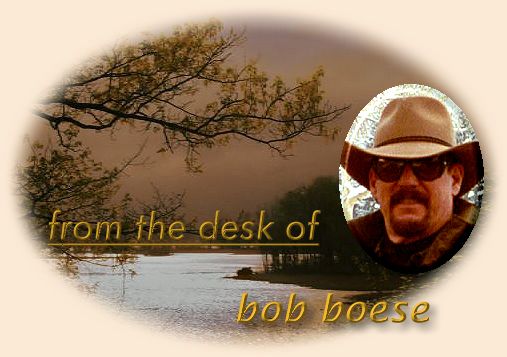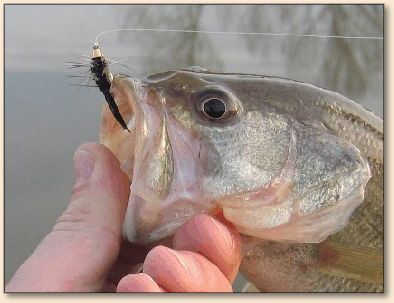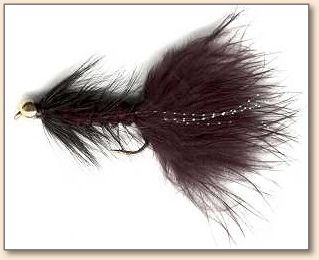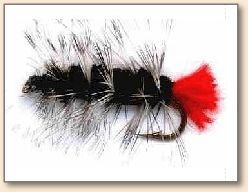
| ||
|
November 17th, 2008
|
|
(Generic flies are simple-to-tie patterns that a novice tyer
can make, which require less than four dressing components
…and which catch fish. None are easier than the woollies.)
 If the new tyer is a typical
I'm-going-to-ask-until-you-answer-me kid, you then have to explain
that even if dressed perfectly it might be taken for a leech, a caterpillar
or worm, a stonefly or dragonfly nymph, a minnow or a wet terrestrial
insect such as a hellgrammite. Sounds sort of generic, and, in fact,
woollies are generic on many different levels: they can be tied in a
rainbow of colors or color combinations, they can be tied in many sizes,
they attract many species of fish, they can have a list of accessories
(e.g. beads, flash, wire ribbing), and the ugliest deformed product
of a beginning tyer's mistake can still catch fish.
If the new tyer is a typical
I'm-going-to-ask-until-you-answer-me kid, you then have to explain
that even if dressed perfectly it might be taken for a leech, a caterpillar
or worm, a stonefly or dragonfly nymph, a minnow or a wet terrestrial
insect such as a hellgrammite. Sounds sort of generic, and, in fact,
woollies are generic on many different levels: they can be tied in a
rainbow of colors or color combinations, they can be tied in many sizes,
they attract many species of fish, they can have a list of accessories
(e.g. beads, flash, wire ribbing), and the ugliest deformed product
of a beginning tyer's mistake can still catch fish.
GENERIC WOOLLY FLY
Head: (optional) metal bead or cone. Thread: flat waxed nylon or 6/0. Body: chenille or ultra chenille. Hackle: neck hackle. Wire: copper or brass .32 gauge. Tail: Woolly Bugger — maribou. Woolly Worm — wool yarn or hackle fibers
1b. (with or without bead) Wrap hook shank with thread to form base for other materials. 2a. (optional) Put 8-10 wraps of lead wire around shank and cover with thread. If using a bead or cone, wrap the lead up to the back of the bead. 2b. Take a small clump of maribou or soft down from the base of a feather (or a small clump of wool yarn for the woolly worm) about the length of the hook and tie in over the hook bend extending backward. For the woolly bugger tie in 3 strands of krystal flash. Trim the woolly worm yarn until it is only 1/4 inch long. Red is the most popular color for woolly worm tails. 3a (optional) Tie in wire with excess hanging down past hook bend. 3b. Tie in a neck hackle by the butt of the feather extending over the hook bend. 4. Tie in chenille and move thread to 1/4" behind the hook eye (or up to the bead). 5. Wrap chenille clockwise to the thread and tie down. Cut off excess chenille. 6. Wrap the hackle clockwise toward the eye of the hook, dull (concave) side toward the hook bend, spacing the wraps. The hackle may snug down between the wraps of chenille, and this is okay. Tie off where the chenille stopped. 7a (optional) Wrap the wire counter-clockwise, wiggling to get between the barbs of the hackle, spacing wraps until the thread (or bead) is reached. 7b. Whip finish a small round head or whip finish smoothly behind the bead. 8. Put a drop of Hard As Nails on the thread. ~ Bob
About Bob:Robert Lamar Boese has fly fished for five decades. He is an environmental negotiator, attorney and educator who has provided environmental legal services for more than thirty-three years including active duty with the U.S. Coast Guard and Department of Justice. He is a well known fly tyer with several unique patterns to his credit. He has developed and authored federal and state regulatory programs encompassing a broad spectrum of environmental disciplines, has litigated environmental matters at all levels of the federal and state court systems, and is a qualified expert for testimony in environmental law. He has authored over 60 published text chapters, comments or articles on environmental matters, is a member of the Colorado, District of Columbia and Louisiana Bar Associations, and is a certified mediator. In addition to his legal practice, Mr. Boese has been a high school teacher, an associate professor of Environmental Law and Public Health, has authored numerous fiction and sports publications, and is a softball coach and nationally certified volleyball referee. He is the president of the Acadiana Fly Rodders in Lafayette, Louisiana and editor of Acadiana on the Fly. He has been married for thirty years and is the father of two fly fishing girls (25 and 21). For additional information contact: Boese Environmental Law, 103 Riviera Court, Broussard, LA 70518 or call 337.856.7890 or email coachbob@ymail.com.
|
|
Previous Bob Boese Columns If you would like to comment on this or any other article please feel free to post your views on the FAOL Bulletin Board! 
|

 1a. (optional) put bead or cone on the hook and thread
it to the hook eye.
1a. (optional) put bead or cone on the hook and thread
it to the hook eye.